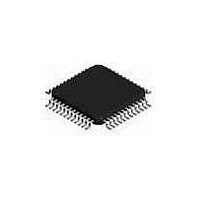C8051F226-GQR Silicon Laboratories Inc, C8051F226-GQR Datasheet - Page 16

C8051F226-GQR
Manufacturer Part Number
C8051F226-GQR
Description
IC 8051 MCU 8K FLASH 48TQFP
Manufacturer
Silicon Laboratories Inc
Series
C8051F2xxr
Specifications of C8051F226-GQR
Core Processor
8051
Core Size
8-Bit
Speed
25MHz
Connectivity
SPI, UART/USART
Peripherals
Brown-out Detect/Reset, POR, WDT
Number Of I /o
32
Program Memory Size
8KB (8K x 8)
Program Memory Type
FLASH
Ram Size
1.25K x 8
Voltage - Supply (vcc/vdd)
2.7 V ~ 3.6 V
Data Converters
A/D 32x8b
Oscillator Type
Internal
Operating Temperature
-40°C ~ 85°C
Package / Case
48-TQFP, 48-VQFP
Processor Series
C8051F2x
Core
8051
Data Bus Width
8 bit
Data Ram Size
1.25 KB
Interface Type
SPI, UART
Maximum Clock Frequency
25 MHz
Number Of Programmable I/os
32
Number Of Timers
3 bit
Operating Supply Voltage
2.7 V to 3.6 V
Maximum Operating Temperature
+ 85 C
Mounting Style
SMD/SMT
3rd Party Development Tools
PK51, CA51, A51, ULINK2
Development Tools By Supplier
C8051F226DK
Minimum Operating Temperature
- 40 C
On-chip Adc
8 bit, 32 Channel
For Use With
336-1241 - DEV KIT F220/221/226/230/231/236
Lead Free Status / RoHS Status
Lead free / RoHS Compliant
Eeprom Size
-
Lead Free Status / Rohs Status
Details
Available stocks
Company
Part Number
Manufacturer
Quantity
Price
Company:
Part Number:
C8051F226-GQR
Manufacturer:
Silicon Laboratories Inc
Quantity:
10 000
C8051F2xx
With the CIP-51's maximum system clock at 25 MHz, it has a peak throughput of 25 MIPS. Figure 1.5
shows a comparison of peak throughputs of various 8-bit microcontroller cores with their maximum system
clocks.
1.1.3. Additional Features
The C8051F206, C8051F220/1/6 and C8051F230/1/6 have several key enhancements both inside and
outside the CIP-51 core to improve overall performance and ease of use in end applications.
The extended interrupt handler provides 22 interrupt sources into the CIP-51 (as opposed to 7 for the stan-
dard 8051), allowing the numerous analog and digital peripherals to interrupt the controller. (An interrupt
driven system requires less intervention by the MCU, giving it more effective throughput.) The extra inter-
rupt sources are very useful when building multi-tasking, real-time systems.
There are up to six reset sources for the MCU: an on-board
clock detector, a voltage level detection from Comparator 0, a forced software reset, and an external reset
pin. The RST pin is bi-directional, accommodating an external reset, or allowing the internally generated
reset to be output on the RST pin. The on-board
(digital 1). The user may disable each reset source except for the
software. The watchdog timer may be permanently enabled in software after a power-on reset during
MCU initialization.
The MCU has an internal, stand-alone clock generator that is used by default as the system clock after
reset. If desired, the clock source may be switched "on the fly" to the external oscillator, which can use a
crystal, ceramic resonator, capacitor, RC, or external clock source to generate the system clock. This can
be extremely useful in low power applications, allowing the MCU to run from a slow (power saving) exter-
nal crystal source, while periodically switching to the fast (up to 16MHz) internal oscillator as needed.
16
Figure 1.5. Comparison of Peak MCU Throughputs
25
20
15
10
5
(25 MHz clk)
Silicon Labs
CIP-51
(33 MHz clk)
PIC17C75x
Rev. 1.6
Microchip
V
DD monitor is enabled by pulling the MONEN pin high
V
(33 MHz clk)
DD monitor, a Watchdog Timer, a missing
Philips
80C51
V
DD monitor and Reset Input Pin from
(16 MHz clk)
ADuC812
8051











